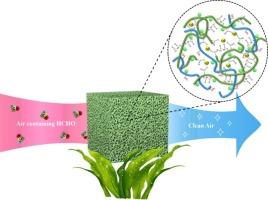Biodegradable aminated alginate-chitosan porous polymer for efficient indoor formaldehyde capture
IF 8.5
1区 化学
Q1 BIOCHEMISTRY & MOLECULAR BIOLOGY
International Journal of Biological Macromolecules
Pub Date : 2025-02-22
DOI:10.1016/j.ijbiomac.2025.141416
引用次数: 0
Abstract
Formaldehyde, even at low concentrations, poses a significant indoor pollutant risk, underscoring the need for efficient and sustainable sorbents. This study introduces a novel, multifunctional, and fully biodegradable adsorbent derived from waste shrimp shells. The shells were converted into soluble chitosan, which was then physically crosslinked with branched amine-modified alginate, resulting in a porous biuret-modified alginate/chitosan (BCC) polymer. BCC, with a 6 wt% biuret content, demonstrated exceptional adsorption performance for low-concentration formaldehyde, achieving a capacity of 1.97 mg·g−1—159% higher than alginate and 149 % greater than activated carbon. The adsorption kinetics followed the pseudo-second-order model, and the Sips isotherm model suggested a chemical adsorption-dominated mechanism, with physical adsorption acting as a supplementary process. Additionally, BCC exhibited excellent reusability, maintaining high adsorption efficiency after four regeneration cycles, and incorporated a colorimetric signaling function, with a detection threshold of 0.07 mg·m−3 and a sensitivity of 0.02 mg·m−3. These findings provide valuable insights and a theoretical basis for developing effective, safe, and environmentally friendly formaldehyde adsorbents.

可生物降解的氨化海藻酸壳聚糖多孔聚合物,用于高效的室内甲醛捕获
即使甲醛浓度很低,也会造成严重的室内污染风险,因此需要高效和可持续的吸附剂。介绍了一种新型的、多功能的、完全可生物降解的虾壳吸附剂。将壳转化为可溶性壳聚糖,并与支胺修饰的藻酸盐物理交联,得到多孔双缩脲修饰的藻酸盐/壳聚糖(BCC)聚合物。双缩脲含量为6 wt%的BCC对低浓度甲醛的吸附性能优异,其吸附量比海藻酸盐高1.97 mg·g−1-159%,比活性炭高149%。吸附动力学服从拟二级模型,Sips等温线模型表明吸附过程以化学吸附为主,物理吸附为辅。此外,BCC具有良好的可重复使用性,在4次再生循环后仍保持较高的吸附效率,并具有比色信号功能,检测阈值为0.07 mg·m−3,灵敏度为0.02 mg·m−3。这些发现为开发有效、安全、环保的甲醛吸附剂提供了有价值的见解和理论基础。
本文章由计算机程序翻译,如有差异,请以英文原文为准。
求助全文
约1分钟内获得全文
求助全文
来源期刊
CiteScore
13.70
自引率
9.80%
发文量
2728
审稿时长
64 days
期刊介绍:
The International Journal of Biological Macromolecules is a well-established international journal dedicated to research on the chemical and biological aspects of natural macromolecules. Focusing on proteins, macromolecular carbohydrates, glycoproteins, proteoglycans, lignins, biological poly-acids, and nucleic acids, the journal presents the latest findings in molecular structure, properties, biological activities, interactions, modifications, and functional properties. Papers must offer new and novel insights, encompassing related model systems, structural conformational studies, theoretical developments, and analytical techniques. Each paper is required to primarily focus on at least one named biological macromolecule, reflected in the title, abstract, and text.

 求助内容:
求助内容: 应助结果提醒方式:
应助结果提醒方式:


